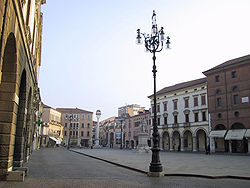Rovigo
Rovigo | |
|---|---|
| Città di Rovigo | |
 Piazza Vittorio Emanuele II. | |
UTC+2 (CEST) | |
| Postal code | 45100 |
| Dialing code | 0425 |
| Patron saint | St. Bellinus of Padua |
| Saint day | November 26 |
| Website | Official website |

Rovigo (Italian:
Geography
Rovigo stands on the low ground known as
Polesine is the name of the low ground between the lower courses of the rivers Adige and
History

Rovigo (both Rodigium and Rhodigium in
In 1194 Rovigo became a formal possession of

With the fall of the 1815-1866
Government
Main sights

The architecture of the town bears the stamp both of Venetian and of Ferrarese influence. Main sights include :
- Palma the Younger.
- Ruins of the Castle (10th century), of which two towers remain
- Madonna del Soccorso: church best known as La Rotonda. If was built between 1594 and 1606 by Alessandro Varotari (il Padovanino), Pietro Vecchia, Pietro Liberi, Antonio Zanchi and Andrea Celesti.
- Immacolata Concezione : Church dating to 1213.
- San Francesco: church in Gothic-Romanesque style but with extensive intervention from the 19th century. The belfry is from 1520. In the interior are several Saints sculptures by Tullio Lombardo (1526).
- The Town hall, which contains a library including some rare early editions, belonging to the Accademia de Concordi, founded in 1580, and a fair picture gallery enriched with the spoils of the monasteries.
- Palazzo Roverella, largely restored but still example of Renaissance architecture, now serves as town art gallery.
- Palazzo Roncale: Renaissance palace (1555) by Michele Sanmicheli
- Palazzo Venezze (1715)
- Pinacoteca dei Concordi ("Concordi Gallery") houses important paintings, including a Madonna with Child and Christ with the Cross by Palma the Elder, a Venus with the Mirror by Jan Gossaert, and portraits by Tiepolo and Alessandro Longhi.
Villages nearby
Barchessa Candiani, Basso Cavallo, Boara Polesine, Boaria San Marco, Borsea, Braga-Cantonazzo, Buso, Busovecchio, Ca'Bianca, Ca'Matte, Ca'Lunga, Campagna Terzi, Campagnazza, Cantonazzo, Capolavia, Ca'Rangon, Concadirame, Corte Lazzarini, Fenile Morosina, Fenil del Turco, Granzette, Grignano Polesine, Grompo, Grumolo, Le Cassette, Le Giarelle, Le Sorbolaro, L'Olmo, Lusia, Mardimago, Roverdicrè, San Sisto, Santa Libera, Santa Rita, Sant'Apollinare, Sarzano and Spianata.
Twin towns – sister cities
Sport

Rovigo is home of
Other practiced sports include football/soccer, swimming, handball, baseball and roller hockey. The "Rosso Blu" as the baseball team is known is at the level of Serie "A" competition. Notable American players who have played for Rovigo Baseball include: Nathan Cardella (Fresno, Ca.) and Mark Peracchi (San Francisco, Ca).
Rovigo is the first Italian city to have a Gaelic football club.[5] Ascaro Rovigo Gaelic Football Club was founded on June 2, 2011. President and founder of Rovigo GAA Raffaello Franco went to Ireland for his honeymoon that year where he watched a football game at Croke Park – he returned home with an O'Neills ball and a dream to set up a GAA club in Italy. Within two years the resulting club's football team of about 90% Italian players are going from strength to strength as they embrace every code that the GAA has to offer. The team colours are red and blue.
Transportation
Rovigo railway station, opened in 1866, forms part of the Padua–Bologna railway, and is also a junction station for two other lines. Heading eastwards, towards Adria and Chioggia, is the Rovigo–Chioggia railway, and heading west, towards Legnago and Verona, is the Verona–Legnago–Rovigo railway.
See also
References
- ^ "Superficie di Comuni Province e Regioni italiane al 9 ottobre 2011". Italian National Institute of Statistics. Retrieved 16 March 2019.
- Istat
- Rovigo.
- ^ "Città gemellate e amiche". comune.rovigo.it (in Italian). Rovigo. Retrieved 2021-03-28.
- ^ "Biggest-ever GAA weekend in Europe". GAA.ie. June 11, 2013. Archived from the original on 20 June 2013.
Sources
- This article incorporates text from a publication now in the public domain: Chisholm, Hugh, ed. (1911). "Rovigo". Encyclopædia Britannica. Vol. 23 (11th ed.). Cambridge University Press. pp. 781–782.
- Various (1988). Rovigo. Ritratto di una Città. Rovigo: Minelliana.



